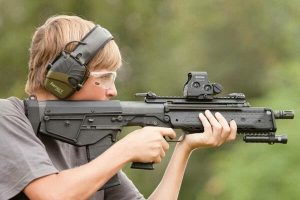Unmagnified Optics: Red Dot Vs Holographic Vs Prismatic Sights
BY PGFReflective optics for artillery have been around since before World War One. With the massive rounds of the Great War, it makes sense – who would want to put their eye next to a scope ocular on a rifle with enough recoil to give shooters a black eye?
At first, these ambient light and half-mirror, “powered” reflex sights were confined to artillery and aircraft. They were simply too bulky and too daylight-dependent for small arms use. After World War Two, reflective optics were offered for sporting guns but were not considered suitable for individual military weapons.

Photo, Oleg Volk
The first “red dot” in relatively wide military use was actually an Armson OEG (occluded eye gunsight), a fiber optic presenting a bright dot to the dominant eye but occluding the target from it. The occlusion guaranteed a high-contrast aiming point, while the non-dominant eye would see the target, and the brain would superimpose the two for a sight picture. Although useful for short-range aiming and quick in use, OEG sights did not gain overwhelming popularity.
Around the end of the 20th century, the battery-operated Aimpoint red dot sight went mainstream with the US military as the M68 Close Combat Optic. Unlike a reflector sight that used a flat half-mirror and a lens-collimated optical source outside the line of sight, the M68 uses a curved semi-reflective mirror to direct the reticle toward the shooter’s eye. The use of a single-wavelength LED permits a long battery life and also allows the passing of all other wavelengths of light through the half-mirror.
There’s some history; read the interesting breakdown of advantages and disadvantages at the link. As always, readers’ insights and experience are welcomed.




